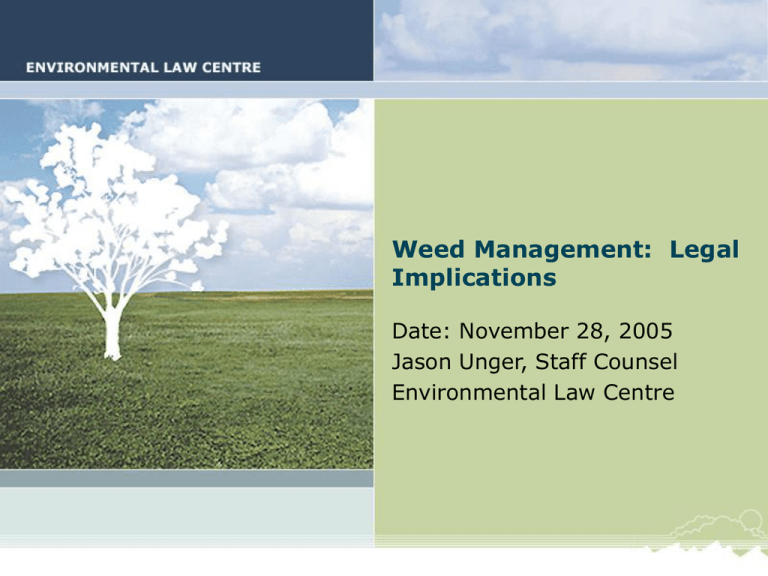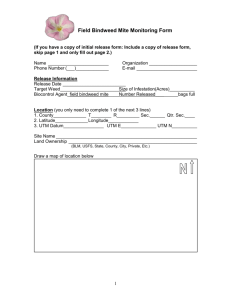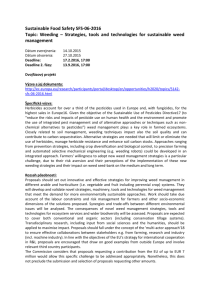View the Weed Management and Law Presentation here 218.50 Kb
advertisement

Weed Management and the Law Weed Management: Legal Implications Date: November 28, 2005 Jason Unger, Staff Counsel Environmental Law Centre Weed Management and the Law The Environmental Law Centre • Vision – A clean, healthy and diverse environment protected through informed citizen participation and sound law and policy, effectively applied. • Mission – To ensure that laws, policies and legal processes protect the environment. • Ends – Enactment and effective enforcement of sound environmental laws and policies. – Effective and informed public participation in environmental regulatory, law-making and decision making processes. Weed Management and the Law ELC’s Public Programs • Information and referral • Legal education • Public library of environmental law • Environmental law monitoring and reform • Legal research Weed Management and the Law Legal Aspects to Weed Management • Types of Liability – Regulatory – Civil • Minimizing Liability – Delegating liability – Risk Management and Due Diligence • Limitations on Liability – Limitations Act – Other limitations Weed Management and the Law Civil & Regulatory Liabilities • Environmental liabilities – Two main areas of potential liability • Regulatory –statutory • Civil – civil liability more likely at issue in relation to work with herbicides (if application, storage and handling is unlawful) Weed Management and the Law Regulatory offences • Classes of offences: – mens rea: requires actus reus (guilty act) & mens rea (guilty intent) – strict liability: upon proof of actus reus, accused must prove due diligence to escape conviction – absolute liability: only actus reus must be proven to convict – Ticketable or administrative penalties –often like absolute but often carry limited rights to appeal and not in court Weed Management and the Law Due diligence Defence to strict liability offences • – Operates as a full defence – If successfully shown, no offence exists – Crown must first prove actus reus committed • Proven by accused on balance of probabilities – that all reasonable steps were taken to prevent commission of the offence • Prove by showing no negligence - will vary in each case Weed Management and the Law Due diligence – suggested factors (R. v. Gonder) • General business/industry standard of care • Special circumstances indicating different level of care – Gravity of potential harm – Available alternatives – Likelihood of harm – Knowledge/skill expected of defendant – Extent to which causes beyond defendant’s control Weed Management and the Law Statutes of Relevance • Environmental Protection and Enhancement Act – Pesticide (Ministerial) Regulation – Pesticides Sales, Handling, Use and Application Regulation – Code of Practice for Pesticides • Weed Control Act – Weed Regulation • Federal Pest Control Products Act – Pest Control Products Regulation Weed Management and the Law Example Case of Regulatory Liability • Municipal District of Cardston No. 6 v. Direct, Enforcement and Monitoring Division, Alberta Environment Protection (17 August 1999) 99-011 (EAB) – Administrative penalty for violating section 5 of the Pesticide Sales, Handling, Use and Application Regulation and s 9 of the Pesticide (Ministerial) Regulation – Applying pesticide in manner which causes or is likely to cause an adverse effect and using a restricted pesticide within 30 metres of an open body of water (without special use approval) – $5000 penalty upheld by EAB Weed Management and the Law Civil causes of action • Operate separately & independent of regulatory liability • Regulatory liability may be evidence in a civil action, but does not determine civil liability • Ultimately determined by courts Weed Management and the Law Trespass • Direct interference with another’s property, property interest or person without lawful excuse or justification • Liability unless defence • Defences: – involuntary act – consent – necessity – statutory authority • Remedies: damages &/or injunction Weed Management and the Law Private nuisance • Unreasonable interference with use & enjoyment of private property – direct, physical entry not required – balance of rights – substantial interference – does not apply to abnormal/delicate uses of property • Remedies: damages &/or injunction Weed Management and the Law Negligence • 3 elements – duty of care owed by defendant to plaintiff – breach of that duty - failure to meet legal standard of care (“reasonable person” test) – loss or injury resulting from breach (causation) • Defences: failure to prove elements of tort; contributory negligence • Remedy: damages Weed Management and the Law Defence of Statutory Authority • often used often unsuccessful • based on premise that the defendant is authorized or permitted to do an activity that causes harm by legislation • Courts construe the ability to impinge on other’s private property rights narrowly – Question to be asked is whether the harm could be avoided – Statutory authorizations are understood to imply that every effort will be made to avoid the harm Weed Management and the Law Past Case Law • Nuisance and Trespass claims have been successful in the past • Statutory authority often rejected on basis that not enough was done to avoid the harm • Newman v. Conair Aviation Ltd, Friesen v. Forest Protection ltd Weed Management and the Law Liability through actions of others • Regulatory and civil liabilities can accrue through – Agents – Independent Contractors – Employees • Vicarious liability is often expressly stated in the legislation – possible where actions of agents, independent contractors or employees cause the damage – Question is whether harm is caused by activity during the course and within the scope of the employment – sub-contractors or independent contractors may insulate against liability to a degree but a municipality may remain liable by virtue of its statutory obligations Weed Management and the Law Notes regarding sub-contracting • Municipality, as land manager, is responsible and may still be liable for activities taking place on land • If seeking indemnity from sub-contractor must be express in terms of contract • Must also ensure contractual terms recognize the responsibilities of parties • Legislative responsibilities cannot be delegated Weed Management and the Law Minimizing Liabilities • Policy and operational measures are required to avoid environmental liabilities 1. Due diligence, Risk Assessment and Risk Management 2. What it means in operation Weed Management and the Law Due Diligence, Risk Assessment & Risk Management • Risk assessment and management systems are important in establishing due diligence – Have systems in place to • Assess risks – Identify risks – Identify legal (civil/regulatory) obligations • Manage risks – Practice and policy manuals – Management framework for targeting risky activities and mechanism for monitoring and enforcement • Communicate the risks – Ensure proper training – Ensure due diligence in sub-contracting Weed Management and the Law Operationalizing a Risk Management System http://www.tbs-sct.gc.ca/pubs_pol/dcgpubs/RiskManagement/guide12_e.asp Weed Management and the Law In Practice • Risks Identified – Practices in pesticide/herbicide use and disposal – Prohibited spray areas –under EPEA, adjacent land owner concerns • Managing risks – Ensure policies expressly deal with identify risks – Ensure those doing work take on as much responsibility as possible (eg. Sub-contractors indemnity clauses) – Identify and use strategies for risk prevention – alternatives for minimizing possibility of liability (choice of weed control technique) Weed Management and the Law In Practice continued • Communicating risks – Ensure: • Proper training/certification • Proper supervision • Proper response plans in event of harm or unlawful conduct Weed Management and the Law Due Diligence in Practice • Establishing Due Diligence requires evidence that all reasonable steps were taken to avoid the offending act – This means • Detailed records of substances used (without them it is difficult to prove proper monitoring and enforcement of risk management policies) • Location of application • Weather conditions Weed Management and the Law Limitations on Liability • Civil Liability governed by the Limitations Act – two years from the cause of action arising – – Discoverability principle - starts running at time that you knew or ought to have known of damage • herbicide residue issue • Backdrop is 10 years • Ongoing causes of action and damage may allow extension • Regulatory Liability often dictated by Legislation – EPEA • 2 years from date of offence or when Director became aware of offence (s.226) Weed Management and the Law Other limitations may apply • Municipal Government Act limits legal action regarding maintenance of public places, roads and public works – 30 day notice to municipality (failure of which bars action) exceptions exist • EPEA section 218 – Statutory provision to allow extension for releases of substance that causes adverse effect (subject to discoverability test) Weed Management and the Law Contacting the Environmental Law Centre 204, 10709 Jasper Avenue Edmonton, AB T5J 3N3 Phone: 780-424-5099 or 1-800-661-4238 Fax: 780-424-5133 E-mail: elc@elc.ab.ca Web: www.elc.ab.ca




